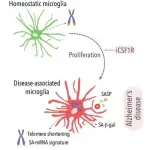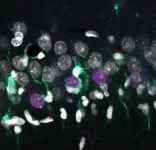Scientists discover immune cell behavior that plays a key role in Alzheimer's disease
2021-06-08
(Press-News.org) A new study has pinpointed a small group of cells in the brain which could be crucial to understanding how Alzheimer's disease begins and how to slow its progression. This discovery could help research into treatment for the disease by focusing on this key group of cells in the brain.
Alzheimer's disease is the most common type of dementia, affecting between 50 and 75 per cent of those diagnosed. There are currently around 850,000 people with dementia in the UK. This is projected to rise to 1.6 million by 2040.
"Alzheimer's disease evolves over decades but we currently lack an understanding of the events that take place in the early stages," explained Dr Diego Gomez-Nicola of the University of Southampton who led this research.
The Southampton team had already discovered that microglia, the brain's main immune cells, are the first cells to react to the build-up of a protein called amyloid, which is associated with the development of dementia, by increasing in number.
In this new study, published in the journal Cell Reports, Dr Gomez-Nicola and his team set out to explore whether this sustained encounter between microglia and amyloid would impose long-lasting changes in microglia that would influence the speed at which the disease develops.
Using a mouse model of Alzheimer's disease-like pathology, the researchers found key evidence that the sustained activation of microglia leads to a fraction of these cells becoming senescent, a state of metabolic and inflammatory dysfunction. These senescent microglia in turn accelerated the accumulation of amyloid, impacting the early stages of the development of the disease. The findings were validated in human post-mortem samples from patients with Alzheimer's disease.
"We have previously established that microglia respond to toxic amyloid by proliferating, which is part of their function as immune cells, they are trying to contain a foreign protein," said Dr Gomez-Nicola.
"However, this is the first time we have seen the long-term consequences of this proliferation on the cells, and the impact for the development of the disease."
The research team then discovered that by halting the proliferation of microglia in mice, they could slow down the rate at which senescence occurred which in turned reduced the level of toxic amyloid in the brain. This could have major implications for slowing down the progression of the disease.
Dr Gomez-Nicola continued, "These findings have pinpointed a small group of microglia that have a profound influence on the rate at which Alzheimer's disease accelerates. As well as providing scientists with more insight into the starting point of the disease, it will enable future research and drug discovery efforts to be refined to target these senescent cells specifically, and hopefully expedite further breakthroughs in the search for effective treatments."
Researchers used the APP/PS1 mouse model for this study. All procedures were performed in accordance with UK Home Office regulations. The University of Southampton has a long-standing track record in complying with all legal requirements involving animal research and is amongst a number of organisations in the UK signed up to the Concordat on Openness on Animal Research.
INFORMATION:
[Attachments] See images for this press release:

ELSE PRESS RELEASES FROM THIS DATE:
2021-06-08
MELVILLE, N.Y., June 8, 2021 -- Variations in children's speech has traditionally been attributed to developmental delays. Recent work suggests the reasons for variability are not so clear, and an immediate call for treatment may need to be reconsidered.
During the 180th Meeting of the Acoustical Society of America, which will be held virtually June 8-10, Margaret Cychosz, from the University of Maryland, will discuss the need to better understand these variations. Her presentation, "Reconsidering variability in child speech production," will take place ...
2021-06-08
Neural replay during waking rest may contribute to memory consolidation of action sequences in humans, according to a study published June 8 in the journal Cell Reports. Brain imaging results revealed fast, repeated reactivation of a neural network representing a behavioral sequence that people were learning--approximately 20 times the speed of the new memory--especially while they were taking breaks from practice.
"This is the first demonstration of wakeful neural replay of a newly learned skill elicited by practice in humans," says senior study author Leonardo G. Cohen (@LeonardoGCohen) ...
2021-06-08
What The Study Did: The findings of this observational study of the association of race/ethnicity with COVID-19 infection rates and the interaction of pre-COVID experiences of food insecurity suggest that the association varied over time and across racial/ethnic groups.
Authors: Mare Sarr, Ph.D., of Pennsylvania State University in University Park, is the corresponding author.
To access the embargoed study: Visit our For The Media website at this link https://media.jamanetwork.com/
(doi:10.1001/jamanetworkopen.2021.12852)
Editor's Note: The article includes funding/support disclosures. Please see the article for additional information, including other authors, author contributions and affiliations, conflict of interest and financial disclosures, and funding and support.
INFORMATION:
Media ...
2021-06-08
What The Study Did: This study tracked COVID-19 outcomes for 543 individuals with intellectual and developmental disabilities who were receiving support services from an organization providing residential services in the five boroughs of New York.
Authors: Scott D. Landes, Ph.D., of Syracuse University in New York, is the corresponding author.
To access the embargoed study: Visit our For The Media website at this link https://media.jamanetwork.com/
(doi:10.1001/jamanetworkopen.2021.12862)
Editor's Note: The article includes funding/support disclosures. Please see the article for additional information, including other authors, author ...
2021-06-08
What The Study Did: Researchers found differences in sociodemographic and clinical characteristics by entry location for SARS-CoV-2 testing within a safety-net health system. White and English-speaking individuals disproportionately initiated testing via telehealth visits, while Black, Native American and non-English-speaking patients disproportionately initiated testing through the emergency department.
Authors: Rohan Khazanchi, B.A,. Hennepin Healthcare Research Institute in Minneapolis, is the corresponding author.
To access the embargoed study: Visit our For The Media website at this link https://media.jamanetwork.com/
(doi:10.1001/jamanetworkopen.2021.12857)
Editor's ...
2021-06-08
CHICAGO --- Some leaders in health care have called for an end to annual health check visits, saying they're a waste of time for patients and overworked primary care physicians and don't reduce the risk of death.
A new Northwestern Medicine study found while there is no clear proof that regular check-ups help adults live longer or prevent cardiovascular events like heart attacks or strokes, they still have many health benefits - especially for at-risk populations - and should continue.
Routine check-up visits (they don't have to necessarily be done annually) ...
2021-06-08
Decisions made now will determine whether economies win or lose money as the coal industry changes over the next couple of decades.
Countries including Australia and Indonesia could lose billions of dollars if they continue to invest in new coal mines and exports as the world moves away from fossil fuels.
These are the conclusions of a new analysis led by a team from Imperial College London and including researchers from Queen Mary University of London and Deloitte, which is published today in the journal Joule.
The team combined data on coal resources and demand in an economic model of trade and prices. ...
2021-06-08
BOSTON -- Death rates from chronic conditions like lung disease and cardiovascular disease and so-called "diseases of despair" such as opioid overdoses are known to be higher in rural areas than in large cities, with differing economic, social and political circumstances influencing people's access to care. To examine disparities in mortality rates for all causes of death, researchers from Brigham and Women's Hospital used a Centers for Disease Control and Prevention (CDC) database to analyze all deaths occurring in the U.S. between 1999 and 2019. They found that age-adjusted mortality rates (AAMRs) declined in both rural and urban populations, but that the gap between the death rates dramatically widened as white individuals aged 25 to ...
2021-06-08
Amyotrophic lateral sclerosis (ALS) is a severe, fatal neurodegenerative disorder causing loss of motor neurons and voluntary muscle action. While mouse studies have identified potential treatments, these drugs have typically done very poorly in human trials. Researchers at Boston Children's Hospital, working in collaboration with Pfizer, now report a high-throughput target and drug discovery platform using motor neurons made from ALS patients. Using the platform, they confirmed two known targets and identified an existing class of drugs -- agonists to the dopamine D2 receptor -- as potential novel treatments.
The researchers, led by Clifford Woolf, MD, PhD, director of the F.M. Kirby Neurobiology Center at Boston Children's, and first authors Xuan Huang, PhD, and Kasper Roet, PhD, ...
2021-06-08
A multidisciplinary team led by researchers from the Spanish Research Council (CSIC) identifies the genomic cellular map associated with hippocampal sclerosis, a major histopathological condition of temporal lobe epilepsy. The study, published in Cell Reports, identifies cell-type specific transcriptional signatures of hyper-excitability and neurodegeneration, providing grounds for improved diagnosis. While the presence of sclerosis is essential for identifying temporal lobe epilepsy (the most common form of drug-resistant epilepsy), it is also detected in some cases of dementia associated ...
LAST 30 PRESS RELEASES:
[Press-News.org] Scientists discover immune cell behavior that plays a key role in Alzheimer's disease


